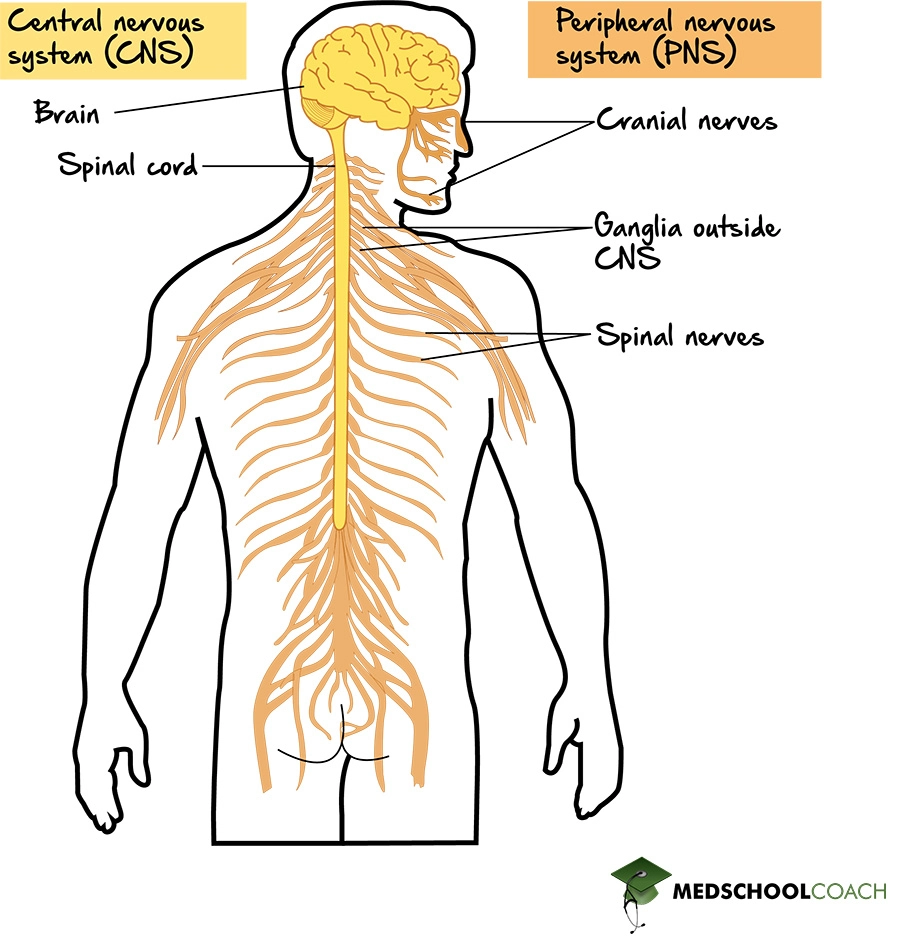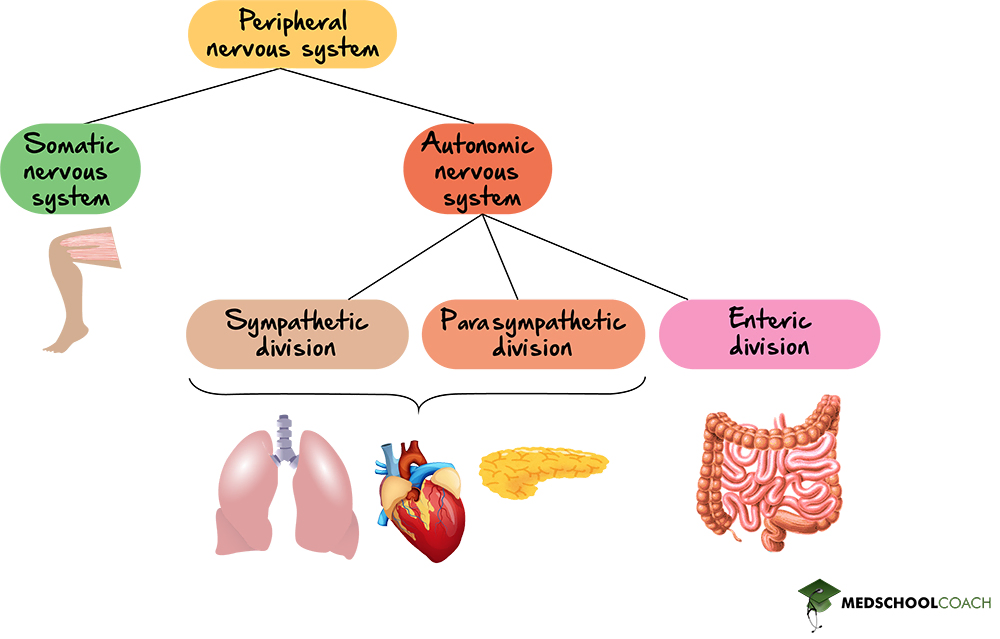Nervous System Structure & Function
MCAT Biology - Chapter 7 - Section 1.1 - Organ Systems - Nervous System Structure & Function
- Home
- »
- MCAT Masterclass
- »
- Biological and Biochemical Foundations of Living Systems
- »
- Biology
- »
- Nervous System Structure & Function – MCAT Biology
Sample MCAT Question - Nervous System Structure & Function
a) The autonomic nervous system, which is part of the peripheral nervous system.
b) The somatic nervous system, which is part of the peripheral nervous system.
c) The enteric nervous system, which is part of the autonomic nervous system.
d) The sympathetic nervous system, which is part of the autonomic nervous system.
B is correct. The somatic nervous system, which is part of the peripheral nervous system.
The vertebrate nervous system is made up of both the central nervous system and the peripheral nervous system. Within the peripheral nervous system is the autonomic nervous system, which controls involuntary functions, and the somatic nervous system, which controls the voluntary contraction of the skeletal muscle. Note: While the cell bodies of motor neurons are located in the central nervous system, motor nerves, which are bundles of axons from motor neurons, are part of the peripheral nervous system, and the motor nerves that control the voluntary contraction of skeletal muscle are located in the somatic nervous system specifically.
Get 1-on-1 MCAT Tutoring From a Specialist
With MCAT tutoring from MedSchoolCoach, we are committed to help you prepare, excel, and optimize your ideal score on the MCAT exam.
For each student we work with, we learn about their learning style, content knowledge, and goals. We match them with the most suitable tutor and conduct online sessions that make them feel as if they are in the classroom. Each session is recorded, plus with access to whiteboard notes. We focus on high-yield topics if you’re pressed for time. If you have more time or high-score goals, we meticulously cover the entire MCAT syllabus.
Nervous System
Nervous System Functions
The vertebrate nervous system has three primary functions: high-level control over body systems, integration of sensory information, and adaptation to external influences. For the MCAT, it is important to understand these three functions in detail.
Function #1: High-Level Control
Nervous system control over the body includes not only voluntary control of limbs but also involuntary control over several critical physiological processes. For example, digestion is a complex process partially controlled by the nervous system. When food particles enter the GI tract, the GI system will release enzymes and gastric juices to digest the food. However, even before food is physically ingested, the sight, smell, or even thought of food will trigger the brain to stimulate the GI tract to start releasing digestive juices and enzymes. This process essentially primes the body for feeding.
To give another example, the nervous system also exerts control over the reproductive system. Oxytocin, for instance, which is a hormone that controls uterine contraction during childbirth as well as lactation, is released from the periventricular cells of the hypothalamus in the brain. The hypothalamus also controls endocrine functions such as the regulation of the thyroid gland and the secretion of stress hormones from the adrenal gland.
Function #2: Sensory Integration
The nervous system has many sensory neurons that detect both external and internal stimuli. Photoreceptors in the eye, for instance, receive visual stimulus from the outside world, and nociceptors located on the skin detect injuries and facilitate pain. Internally, nociceptors detect the state of your GI system, eliciting feelings of comfort or discomfort, and baroreceptors detect changes in blood pressure based on the stretch of carotid arteries.
In the brain and spinal cord, sensory information is integrated and processed, thereby allowing the organism to respond appropriately. This is not always conscious. For instance, a person who accidentally touches a hot stove will reflexively pull their hand away before they feel the sensation of pain. This is because the hand-withdrawing reaction is mediated entirely by neurons in the spinal cord, without input from the brain.
Function #3: Adaptation to the Environment
Nervous System Structure & Organization
The vertebrate nervous system can be divided into the central nervous system and the peripheral nervous system (see Figure 1). The central nervous system, or the CNS, consists of the brain and the spinal cord. The peripheral nervous system, or the PNS, consists of neurons whose cell bodies are located outside the brain and spinal cord, as well as the nerves that exit the brain and spinal cord to various parts of the body.

Divisions of the Peripheral Nervous System
The PNS can be further divided into the somatic nervous system and the autonomic nervous system (see Figure 2).
The somatic nervous system is under voluntary control. It includes sensory neurons that receive information from the skin, muscle, and joints, as well as motor neurons that control skeletal muscle contractions. An example of a somatic nervous system function is the voluntary movement of an arm or a leg.
The autonomic nervous system, on the other hand, is under involuntary control. Like the somatic nervous system, it includes both sensory and motor neurons. Sensory neurons in the autonomic nervous system receive information from the viscera and can detect things like GI discomfort or even stomach distension when a person is full. Motor neurons in the autonomic nervous system control the contraction of smooth muscle (e.g. peristaltic contractions in the GI tract) as well as secretions from glands (e.g. gastric acid secretion in the stomach).
Divisions of the Autonomic Nervous System
The autonomic nervous system can be further subdivided into the parasympathetic, sympathetic, and enteric nervous systems (see Figure 2).
The parasympathetic and sympathetic nervous systems are antagonistic to each other. The parasympathetic nervous system drives “rest and digest” processes, which are especially prominent after eating. These processes include salivation, urination, digestion, defecation, lacrimation, and sexual arousal. The sympathetic nervous system, by contrast, drives “fight or flight” responses that are prominent during a perceived attack or threat to survival. Such responses can include pupillary dilation, increases in heart rate and stroke volume, reduction of GI function, and activation of sweat secretion.
Lastly, the enteric nervous system refers to the neurons within the GI tract that regulate GI functions such as peristalsis and the secretion of GI hormones.

Explore More MCAT Masterclass Chapters
Take a closer look at our entire MCAT Masterclass or explore our Biochemistry lessons below.

One-on-One Tutoring
Are you ready to take your MCAT performance to a whole new level? Work with our 99th-percentile MCAT tutors to boost your score by 12 points or more!
See if MCAT Tutoring can help me
Talk to our enrollment team about MCAT Tutoring

MCAT Go Audio Course
Engaging audio learning to take your MCAT learning on the go, any time, any where. You'll be on the way to a higher MCAT score no matter where you are. Listen to over 200+ lessons.

MCAT Practice Exams
Practice makes perfect! Our mock exams coupled with thorough explanations and in-depth analytics help students understand exactly where they stand.

MCAT Prep App
Access hundreds of MCAT videos to help you study and raise your exam score. Augment your learning with expert-created flashcards and a question banks.